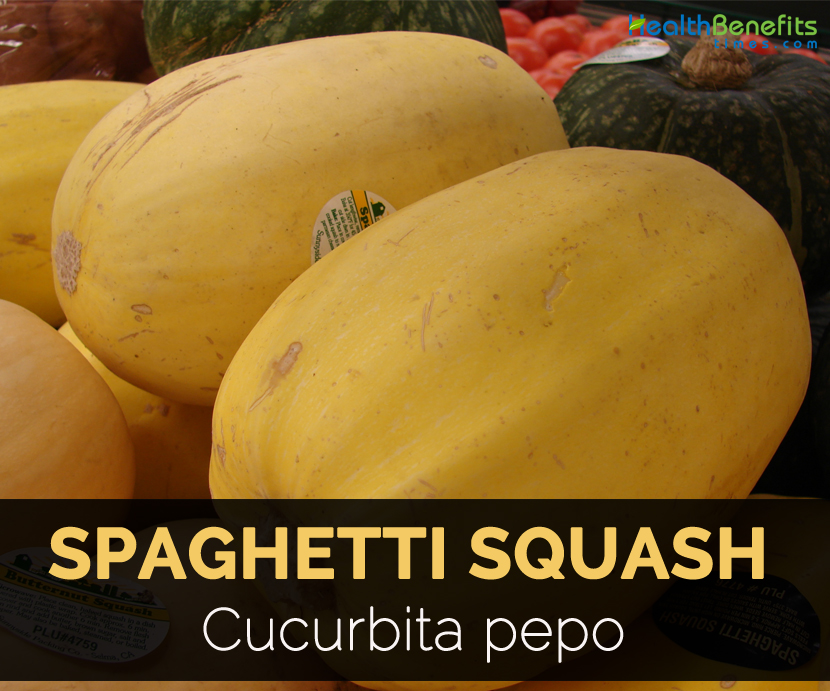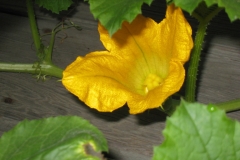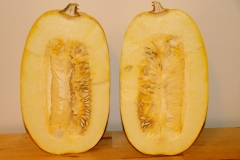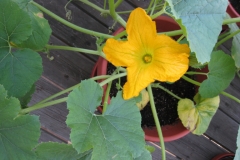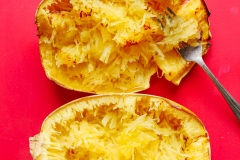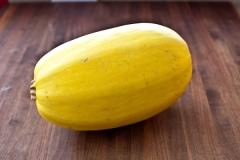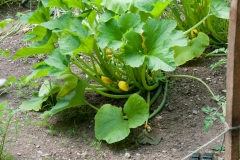| Spaghetti Squash Quick Facts | |
|---|---|
| Name: | Spaghetti Squash |
| Scientific Name: | Cucurbita pepo |
| Colors | Light green turning to ivory to yellow or yellow |
| Shapes | Oblong cylindrical pepo |
| Flesh colors | Yellow, orange or white |
| Name | Spaghetti Squash |
|---|---|
| Scientific Name | Cucurbita pepo |
| Common/English Name | Gold String Melon, Noodle Squash, Fish Fin Melon, Shark-Fin Melon, Spaghetti Marrow, Spaghetti Squash, Spaghetti Melon, Vegetable Spaghetti |
| Name in Other Languages | Chinese: Yú Chì Guā; Dutch: Spaghettikalebas, Spaghettipompoen; Eastonian: Spagetikõrvits; French: Courge Spaghetti, Spaghetti Végétal; German: Spaghettikürbis; Italian: Zucca Spaghetti; Japanese: Kinshi Uri; Portuguese: Abóbora Spaghetti; Spanish: Zapallo Spaghetti; Swedish: Spagettipumpa; Dutch: Sierkalebas; English: Ornamental summer squash, Ornamental gourd; Estonian: Ilukõrvits; French: Courge ornementale, Coloquinte; German: Schmuck-Kürbis, Schmuckkürbis; Italian: Zucca Indiana; Japanese: Kanshou kabocha (観 賞カボチャ) |
| Plant Growth Habit | Semi-bushy herb |
| Growing Climate | Cool |
| Soil | Well-drained, slightly acidic |
| Leaf | Alternate, 20–30 × 20–35 cm |
| Flower | Bright yellow, 10 cm in diameter |
| Fruit shape & size | Oblong cylindrical pepo |
| Fruit weight | 50 kg |
| Fruit color | Light green turning to ivory to yellow or yellow |
| Flesh color | Yellow, orange or white |
| Seed | White, ovoid, flattened, 1–1.5 cm × 0.5–1 cm |
Plant description
Spaghetti Squash is a vigorous annual, monoecious and trailing vine or emi-bushy herb with shallow and extensively branched roots having well developed taproot. Stems are five angled, hard, angular, short to semi-erect and pubescent-scabrous light green. Tendrils are simple and have 2-6 branchlets. Leaves are simple, alternate, broadly triangular usually with deep acute lobes 20–30 × 20–35 cm with denticulate to serrate-denticulate margins. Flowers are pentamerous, solitary, bright yellow and borne in leaf axils. Male flowers have long and light green peduncle about 7-20 cm and tubular corolla 5-10 cm long which is divided into five lobes for upto 1/3 or more of its length. Female flowers have sulcate, sturdy and shorter peduncle of 2-5 cm. Ovary is ovoid, smooth, cylindrical and calyx is small. Fruit is an oblong cylindrical pepo about 12 inches in length and 6 inches in diameter which is light green that turns to ivory to yellow or yellow with white or greenish streaks when mature. It contains ovoid, flattened and white seeds in yellow, orange or white flesh.
Flower
Flowers are monoecious bearing solitary actinomorphic flowers which produce nectar. Calyx is campanulate with five free sepals. Each sepal is linear and 0.9-3 cm long and smaller on pistillate flowers. Corolla is yellow, campanulate, five parted with erect to spreading petals which are apically acute and 5-10 cm long and 3 cm broad. Staminate flowers form on 3-20 cm long peduncle and have 3 stamens with free filaments. Pistillate flowers form on shorter peduncles 2-5 cm long. The plant blooms flower from July to August.
Fruit
Fruits are oval, flattened, scalloped, globular, fusiform, tapering to curved or straight neck on one or both ends. It can be upto 5 times longer than wide. Skin is smooth, wrinkled, warty, furrowed with shallow to deep longitudinal ridges. Fruit is white, yellow or light to dark green. Flesh is variable in color and thickness. Fruit weighs from 30 g to 50 kg which comprises of numerous seeds.
Health Benefits of Spaghetti Squash
Spaghetti squash is nutritious and offers high amount of Vitamin A, potassium, folic acid and beta carotene. Potassium helps to maintain proper muscle and nerve function. Spaghetti squash is rich in minerals such as iron, calcium, zinc and phosphorus as well as B vitamins such as thiamin, niacin and riboflavin.
- Gut health
Sphagetti squash has high content of fiber which offers 2 grams per cup i.e. 10 percent of daily recommended intake. Fiber is crucial for maintaining digestive health. It feeds good bacteria in intestines which is a vital part of digestive and immune system. It promotes digestion by moving slowly through gastrointestinal tract and promotes regularity. Healthy gut provides excellent immunity.
- Weight management
Spaghetti squash is low in carbs and high in fiber which is a perfect substitute for regular pasta for those who are trying to lose weight. A cup of spaghetti squash offers 10% of adults fiber needs for a day. Diet rich in fiber helps to assist weight loss because it promotes satiety which means feeling of fullness. The fiber helps to prevent overeating and indulging in sugary cravings.
- Rich in antioxidants
Foods such as oranges, pomegranates, spaghetti squash and kale have good amounts of antioxidants. Spaghetti squash has beta carotene and Vitamin C that helps to prevent chronic diseases and inflammation. Antioxidants has the ability to combat cell damaging free radicals and toxins. The damaged cells when replicate, it creates high changes for inflammation and chronic disease. It is loaded with other essential nutrients such as magnesium, potassium and manganese. It is also rich in Vitamin A which is beneficial for eye health and B vitamins contributes to proper cell functioning.
- Low glycemic
Spaghetti squash is a food low in glycemic for more even blood sugar levels. Low glycemic index won’t cause sudden spike in blood sugar like higher carbohydrate alternatives. It has polysaccharides which is a type of fiber preventing blood sugar from rising after meals.
- Combat inflammation
Spaghetti squash has omega-3 fatty acids which makes it anti-inflammatory and overall health.
Traditional uses
- In Central and North America it is used as medicine.
- It is effective in eliminating tapeworms. Take an emulsion made from grounded seed with water.
- Seeds act as mildly diuretic and vermifuge.
- Apply the leaves externally to burns.
- Use the fruit pulp as decoction to provide relief from intestinal inflammation.
- Use the fruit for loose stools, throat infection and eye infections.
- Seeds are used to cure painful chests, fever, bronchitis, kidney problems and reduce thirst.
- Seeds are used for treating hypertrophy of prostate.
- Use the fruit pulp as decoction to provide relief from intestinal inflammation.
Culinary uses
- Spaghetti squash can be baked, steamed, boiled or micro-waved.
- Serve it with sauce as a substitute for pasta.
- Roast the seeds.
- Ground the seeds and mix it with cereals for making bread.
- Sprout the seeds and use it in salads.
- Use the seeds to extract oil.
- Cook young leaves and stems as potherb.
- Cook the stems and leaves as potherb.
- In West Africa, fruits are used in soups and couscous.
- Shoots and young leaves are used as potherb.
- Seed oil is used in cooking.
- Immature fruits are consumed raw, fried or cooked.
- Mature fruits are added to pies, soups and other baked goods.
- It pairs well with onions, tomato, greens, garlic, fresh herbs such as basil, thyme, parsley, oregano, mint, zucchini, cucumbers, red pepper, bell pepper, soy sauce, snap peas, tamari, fish sauce, cream, pine nuts, cream, mozzarella, ricotta, shrimp, ground beef, chicken, pancetta and Italian sausage.
Precautions
Some people might be allergic to spaghetti squash causing food allergy symptoms such as itching, hives, digestive issues and swelling.
References:
https://www.itis.gov/servlet/SingleRpt/SingleRpt?search_topic=TSN&search_value=22373#null
https://en.wikipedia.org/wiki/Cucurbita_pepo
http://tropical.theferns.info/viewtropical.php?id=Cucurbita+pepo
https://www.specialtyproduce.com/produce/Spaghetti_Squash_4145.php
https://en.wikipedia.org/wiki/Spaghetti_squash
https://jovinacooksitalian.com/2013/04/25/spaghetti-squash/
https://www.healthline.com/nutrition/spaghetti-squash#weight-loss
https://www.nutrition-and-you.com/spaghetti-squash.html


